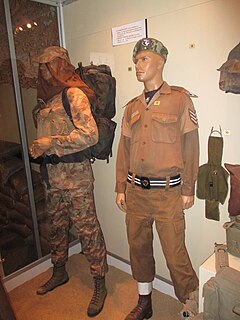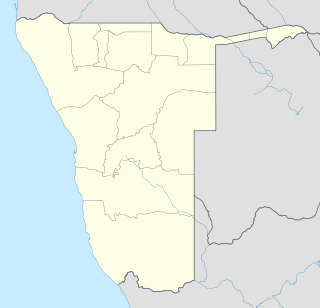
Operation Reindeer, which began on 4 May 1978, was South Africa's second major military operation in Angola, carried out under the Apartheid regime, the first being Operation Savannah.

Operation Daisy was a military operation conducted from November 1–20, 1981 by the South African Defence Force and South West African Territorial Force (SWATF) in Angola during the South African Border War and Angolan Civil War. This conflict was sparked when the South African Defence Force decided to try to halt the regroup of the active military branch of SWAPO, also known as the People's Liberation Army of Namibia.

Operation Displace was a military operation by the South African Defence Force during the South African Border War and Angolan Civil War. It involved maintaining the illusion that the SADF had remained in brigade strength east of Cuito Cuanavale at the end of April 1988 and the eventual withdrawal of all South African military units from south-eastern Angola during August 1988.

Operation Seiljag was a South African 32 Battalion search and destroy campaign conducted against the People's Liberation Army of Namibia (PLAN) from November 1976 to March 1977, during the South African Border War. It was carried out from November 1976 to March 1977 largely on the Yati Strip, a region patrolled by South African security forces parallel to the Angolan border. By February, the fighting had intensified and shifted to about fourteen kilometres into Angola. In the course of a four-month period 32 Battalion had eliminated two PLAN sections, repelled a third incursion across the border, and destroyed three militant bases. The bodies of nineteen guerrillas were recovered, in addition to a cache of mortar bombs and RPG-7 projectiles intended for use on PLAN raids.

Operation Wallpaper was a military operation by the South African Defence Force (SADF) during the Angolan Civil War and South African Border War.

Operation Alpha Centauri (1986) was a military operation organised under the auspices of UNITA by the South African Defence Force during the South African Border War and Angolan Civil War.

Operation Moduler was a military operation by the South African Defence Force (SADF) during the South African Border War. It formed part of what has come to be called the Battle of Cuito Cuanavale. The Angolan objective was to advance south-east to attack the UNITA at Mavinga. The SADF objective was to protect UNITA by stopping that advance. The advance was halted with heavy Angolan casualties. The South African forces and its UNITA allies then began offensive operations against the Angolan forces, who had retreated back to a defensive line east of the Cuito River with the objective of destroying them once and for all.

Operation Packer was a military operation by the South African Defence Force (SADF) during the South African Border War and Angolan Civil War from March to April 1988. This operation forms part of what became known as the Battle of Cuito Cuanavale. Operation Packer was a continuation of Operation Hooper, using fresh troops and equipment. The Cubans' objective was still to secure the town of Cuito Cuanavale to the west of the river from capture. The SADF objective was once again to eliminate the remaining Angolan forces on the east side of the river, so as to ensure that the Angolans were no longer a threat to UNITA in the south-east. Although at the conclusion some Angolan units remained in positions east of the river, the Angolan advance against UNITA was permanently halted, and UNITA lived to fight on. The SADF never attempted to cross the river or to capture the town. Both sides again claimed victory.

Operation Prone was a proposed military operation by the South African Defence Force (SADF) and South West African Territorial Force (SWATF) during the South African Border War and Angolan Civil War between May and September 1988. With the advance of the 50th Cuban Division towards Calueque and the South-West Africa border, the SADF formed the 10 SA Division to counter this threat. The plan for Operation Prone had two phases. Operation Linger was to be a counterinsurgency phase and Operation Pact a conventional phase.

Operation Sceptic was the largest anti-South West Africa People's Organization (SWAPO) sweep during the South African Border War up to that point. The operation was also known as Smokeshell though this was the codename for the People's Liberation Army of Namibia (PLAN) base which was the main focus of the attack. This operation followed Operation Safraan and preceded Operation Klipklop.

Operation Klipklop occurred during the South African Border War between the Republic of South Africa and SWAPO. The operation began at first light on the 30 July 1980 when South African forces attacked SWAPO facilities in Angola. The objective was a PLAN logistics base at the town of Chitado, 5 km from the Namibian border and 35 km east of Ruacana, with the aim of disrupting mortar attacks on the Ruacana hydro-electric scheme.

Operation Mebos occurred during July and August 1982 with the objective of attacking SWAPO's People's Liberation Army of Namibia (PLAN) bases and new regional headquarters in Southern Angola by the South African Defence Force (SADF) based in South West Africa/Namibia. The plan involved the use of South African Air Force helicopters flown from mobile helicopter administrative areas (HAA) with a SADF Tactical Headquarters deep in Angola and protected from possible People's Forces for the Liberation of Angola (FAPLA) attacks by 61 Mechanised Battalion. These helicopters would fly 32 Battalion and paratroopers from the HAA areas to SWAPO targets identified by reconnaissance teams deep in the Angolan bush and by signal and human intelligence.

Operation Southern Cross (1986) was a military operation by the South African Defence Force during the South African Border War and Angolan Civil War.

Operation Konyn was a military operation by the South African Defence Force during the South African Border War and Angolan Civil War. Operation Konyn was launched on 21 August 1981. The operation preceded Operation Protea with the objective of destroying targets at Cahama and Chibemba in Angola. The Angolans had built a series of radar and early warning stations at Cahama, Chibemba, Lubango and Menongue. Attacking the first two target towns would ensure that the People's Armed Forces for the Liberation of Angola (FAPLA) would not interfere with the South African Air Force operations in support of South African Defence Force (SADF) ground troops taking part Operation Protea against People's Liberation Army of Namibia bases.

Operation Excite/Hilti was a set of military operations by the South African Defence Force (SADF) during the Angolan Civil War and South African Border War.

Operation Firewood was a secretive military operation in 1987 by the South African Defence Force (SADF) during the South African Border War.

Operation Dolfyn was a military operation in Angola from May 1983 by the South African Defence Force (SADF) during the Angolan Civil War and South African Border War.

Operation Merlyn was a military operation by the South African Defence Force (SADF), South West African Territorial Force (SWATF) and South West African Police (SWAPOL) during the South African Border War and Angolan Civil War in April 1989. The aim of the operation was to prevent the incursion of PLAN (SWAPO) insurgents into South West Africa/Namibia from bases in Angola. These incursions were in violation of a ceasefire which came into effect on 1 April 1989 via the implementation of United Nations Security Council Resolution 435 and the Tripartite Accord. Initially, these PLAN incursions were tackled by South West African police units and eventually by SADF and SWATF units, released to assist the police having been confined to their bases by the peace agreements. These incursions and the conflict that occurred ended after hastily arranged talks resulted in the Mount Etjo Declaration and an eventual ceasefire.

Operation Egret was a military operation in Angola during September 1985 by the South African Defence Force (SADF) against People's Liberation Army of Namibia (PLAN) during the Angolan Civil War and South African Border War.

Operation Magneto was a military operation in August 1985 to transport UNITA soldiers by the South African Defence Force (SADF) during the Angolan Civil War and South African Border War.



